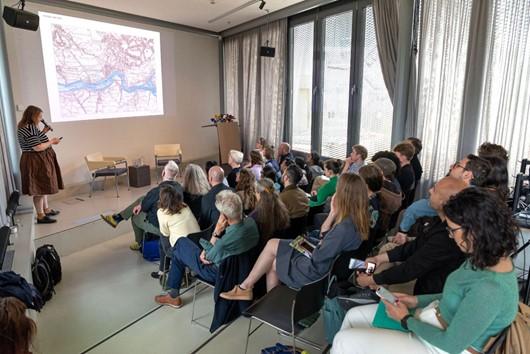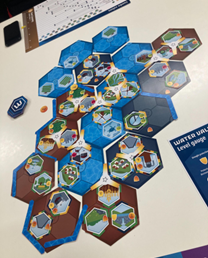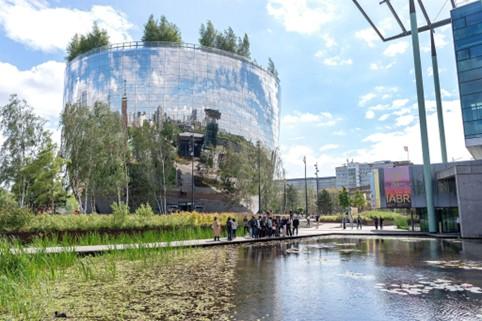Maëlle Salzinger, Alankrita Sarkar, Michael Rodrigues and Carola Hein
In the Delta region between the Netherlands and Belgium, water connects people, land, animals and plants to each other and to global dynamics, including trade and climate change. Water flows irrespective of borders, and the effects of climate change on water systems will affect all Europeans, albeit in different ways. Yet we are witnessing the surge of far-right parties in Europe, which secured one quarter of the seats in the recent European Union parliamentary elections. They are openly promoting an inward-looking, nationalist approach to policy-making instead of a European one. This is symptomatic of the continued struggle to think beyond borders and differences in pursuit of a shared vision for a sustainable Europe.
Focusing on internal and national issues in Europe while ignoring our seas and other water bodies is unsustainable. So what are the alternatives? The kick-off event of the Delta pilot of the Bauhaus of the Seas Sails project, held on World Ocean Day (Saturday 8 June 2024), presented potential solutions. The pilot aims to develop a shared vision for living with water in the Delta together with the inhabitants of the region and implement activities that benefit them.
During the event, the partners of the Delta pilot — Grenspark Groot Saeftinghe, Vereniging Deltametropool, Nieuwe Instituut and Delft University of Technology (TU Delft) — presented the Bauhaus of the Seas Sails project and the Delta pilot to an audience of some 50 people, followed by a guided walk around the Nieuwe Instituut.

The Delta is one of the six pilots of the Bauhaus of the Seas Sails project. Bauhaus of the Seas combines the concepts of ‘marhaus’ (literally ‘the sea as our home’) and ‘baumar’ (‘the sea as a space for creation and impact entrepreneurship’). The project aims to test solutions for climate neutrality and social inclusion through cultural and design-driven approaches in six European countries (the Netherlands, Belgium, Portugal, Italy, Germany and Sweden).

The pilots are turning the three core values of the New European Bauhaus, namely aesthetics, sustainability and inclusion, into new approaches and solutions for different water ecosystems (estuary, lagoon, gulf, strait, river and delta). The kick-off of the Delta pilot highlighted new approaches and examples for sustainable water planning and decision-making in the region. These can be summarised in 4 main takeaways:
1. ‘Streekholders’
Companies and project managers, when planning activities, often consult residents and grassroots groups without giving them real agency over the interventions that affect their lives. ‘Stakeholder engagement’ has come under critique for its ambiguity and disempowering effects.
Instead, the Delta pilot refers to ‘streekholders’ (‘streek’ means ‘region’ in Dutch) who are working together for the future of their region. The pilot acts as a facilitator that supports the agency and efforts of existing initiatives in two locations: the city of Rotterdam and Grenspark Groot Saeftinghe, a border park between the region of Flanders (Belgium) and the province of Zeeland (Netherlands).
Grenspark Groot Saefthinghe is a living example of this approach. The partnership of local municipalities and public agencies works with diverse networks and community members, including streekholders, entrepreneurs, farmers, tourism guides and youth. They facilitate dialogue and inspiration sessions on the future of Saefthinghe and support ambassadors to promote the border park as well as their own initiatives for the area. This collaborative approach is in line with the core value of inclusion in the New European Bauhaus and helps ensure that activities are rooted in a sound understanding of place and context and ultimately benefit locals.
This partnership grew out of the necessity not to repeat past mistakes. Back in 2005, a joint Dutch-Flemish decision to depolder two polders in the area was met with ardent protests. The historical decision to prioritise biodiversity restoration was undermined by its top-down approach, which failed to make the residents of Saeftinghe feel heard.

The efforts of Grenspark Groot Saeftinghe remain essential today, as the region needs to reconcile port, agriculture and sustainability objectives while strengthening social cohesion and cooperation for the long term. Indeed, the Grenspark Groot Saeftinghe partnership will end in 2026, which means streekholders will likely need to sustain their collaboration without a formalised structure and European funding.
2. Intergenerational approach
The next generation will be most impacted by climate change and its effects, which include sea-level rise and changing rainwater patterns in the Delta region. Young people are at the forefront of climate activism, innovation and solidarity networks. Yet they remain largely excluded from sustainability decisions made at the national level as well as at the city level. It is crucial to consider these power dynamics, alongside other socio-economic, racial and gender inequalities, when developing sustainability projects for the benefit of communities.
The Delta pilot works with young people and facilitates intergenerational dialogue via educational initiatives and student projects, in partnership with Studio Makkink & Bey and TU Delft. In Rotterdam, Studio Makkink & Bey are organising educational walks in ‘Het Park’, a park bordering the Nieuwe Maas river that is impacted by sea dynamics like salination. Their approach to education is horizontal, aiming to learn together and value the knowledge that the youth and residents already hold.
But we can do even more to spark dialogue. The pilot is testing learning methods that are stimulating and inspiring for architecture and spatial planning students while exposing them to useful new perspectives on sustainable water planning. For example, TU Delft students travelled to Saeftinghe and played the Water Values board game with the members of Grenspark Groot Saeftinghe. Students saw the place they learned about in class with their own eyes, talked with locals and were confronted with the many (sometimes conflicting) values and interests that cohabit in one place. This allowed students to build an emotional connection with Saeftinghe, thereby also supporting the core value of aesthetics in the New European Bauhaus.


“With the tools of Future Tidal Architecture, we hope that the next generation of architects, designers and spatial planners will be more aware of the value conflicts and trade-offs shaping the decision-making process. This will encourage a sense of ownership to tackle challenges in the Delta in a more sustainable and inclusive way,” explains Alankrita Sarkar, spatial planner at Vereniging Deltametropool.
3. Prosperity with, not against, the river
Our ‘command and control’ approach to water in the Delta is no longer viable, according to Professor Han Meyer (TU Delft). Digging new rivers and artificially deepening the Rhine-Meuse estuary to increase the competitiveness of the Rotterdam port and shipping channels supported the development of the ‘Blue Banana’, Europe’s economic powerhouse. French geographer Roger Burnet theorised the Blue Banana in 1989 as a metaphor for the axis of urbanisation, industrialisation and population density from Liverpool to Milan along the Rhine River, even though today the banana has grown ‘new branches’.

But this big word fails to capture the loss of biodiversity (fish, migratory birds) caused by the digging of the rivers. Nor does it help address the high salination and water levels threatening the city of Rotterdam today. This is a striking example of ‘dissonant heritage’, says Carola Hein, Professor of History and Urban Planning at TU Delft. The ways of living with water that we have inherited and that shape current systems no longer match our values and long-term interests. New models of prosperity and water management are needed that work with the natural dynamics of rivers and sedimentation processes, rather than against them.
“The ways of living with water that we have inherited and that shape current systems no longer match our values and long-term interests.”
How can the Delta pilot and other projects help? A major barrier to change is the Port Authority of Rotterdam, which has a lot of influence over policy-making in the Delta. A purely economic perspective needs to be broadened through democratic discussions that bring together public authorities and the region’s inhabitants to define a shared vision for the future. The Delta pilot can facilitate these discussions about ‘the big picture’ of the Delta by bringing in knowledge from different disciplines, including design, spatial planning, history and culture. Within this effort, the pilot can amplify the voices of citizens and emerging perspectives that reframe prosperity as a long-term process of regeneration that supports all living ecosystems, not just humans.
4. ‘Zoöperation’
Zoöperation, or Zoöp in short, brings together the terms zoë (‘life’ in Greek) and cooperation. It is an innovative model initiated by researcher Klaas Kuitenbrouwer that includes non-humans living ecosystems in the decision-making of an organisation or project. All pilots of the Bauhaus of the Seas Sails project, including the Delta, have adopted the Zoöp with the goal of moving from degenerative to regenerative relationships with nature. This goal of regeneration reaches the highest level of ambition of the New European Bauhaus on the core value of sustainability.
Regenerative approaches, including the Zoöp, operate according to the principle that ‘life creates conditions conducive to life’ in the words of biologist Janine Benyus. The first Zoöp in the world at the Nieuwe Instituut in Rotterdam embodies this principle very concretely. The Delta kick-off event took attendees on a walking tour around the museum to get a first-hand experience of the Zoöp.
‘Life creates conditions conducive to life’, biologist Janine Benyus
The pond around the museum is designed to function as a self-sustaining, regenerative ecosystem. For example, when there is a plan to introduce a sculpture into the pond, the ‘Speaker for the Living’ (the representative of non-human life in the Nieuwe Instituut) informs the museum about how new objects and materials might impact existing life in the pond. The museum can then make sure that the sculpture enriches the pond ecosystem instead of disrupting it. In this way, art becomes integrated into the ecosystem rather than being the ultimate pursuit that destroys other life forms.

What is so promising about the Zoöp is the flexibility of the model. “It is a learning process,” explains Klaas Kuitenbrouwer. In the Bauhaus of the Seas Sails, the Zoöp is being tested by all the pilots. They are conducting workshops (facilitated by the Zoönomic Institute) to identify regenerative relationships they can reinforce in their context with the support of a Speaker for the Living. They are also developing indicators to measure their progress. Ultimately, the goal is to draw lessons from how projects can benefit from the Zoöp model and how to scale up this approach at different levels (local, regional and beyond).
Conclusion
The kick-off of the Delta pilot was successful in enriching the audience’s perceptions of living with water, as indicated by feedback collected at the end of the event. Design students, for example, gained new insights into the social and cultural aspects of living with water, moving beyond technical approaches to understand the diverse values and interests linked to water in the Delta. Some attendees also expressed their intention to take follow-up actions, like using the Zoöp in a non-profit organisation.
The Delta pilot shows a lot of promise, but still, important questions remain for the next year and a half of the project. For instance, in a Delta region where grassroots initiatives and regional networks are already working on sustainability and water education, how do we measure the impact of the Bauhaus of the Seas Sails pilot? How do we capture its contribution to long-term trends in addition to reporting on the direct benefits derived from activities in Rotterdam and Saeftinghe? And how do we compare the Delta pilot with other pilots of the Bauhaus of the Seas Sails project while recognising that they all started from very different contexts?
The Bauhaus of the Seas Sails team is reflecting on these questions intensely and will share their learnings in upcoming PortCityFutures blog articles, among others. An online platform is also being developed to visualise the spatial context, progress and impact of the different pilots, which will be enriched throughout the project.
Stay connected with Bauhaus of the Seas Sails by visiting the project website and subscribing to the newsletter. Please reach out to the team if you would like to bring in a contribution or ask a question.
Alankrita Sarkar <a.sarkar-4@tudelft.nl> (Delta pilot)
Carola Hein <c.m.hein@tudelft.nl> (project leader)
Michael Rodrigues <m.r.rodrigues@tudelft.nl> (geospatial platform)
Maëlle Salzinger <m.s.salzinger@tudelft.nl> (impact assessment)
Acknowledgements
The Bauhaus of the Seas Sails project is a Horizon Europe project funded by the European Commission. We would like to thank our project partners Grenspark Groot Saeftinghe, Vereniging Deltametropool, Nieuwe Instituut and TU Delft for their support and for co-organising the Delta kick-off event. Special thanks also to Jan Bruin for providing photographs that enrich this blog article.
This blog has been written in the context of discussions in the LDE PortCityFutures research community. It reflects the evolving thoughts of the authors and expresses the discussions between researchers on the socio-economic, spatial and cultural questions surrounding port city relationships. This blog was edited by the PortCityFutures editorial team: Yi Kwan Chan and Vincent Baptist.
